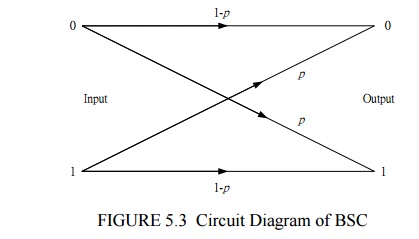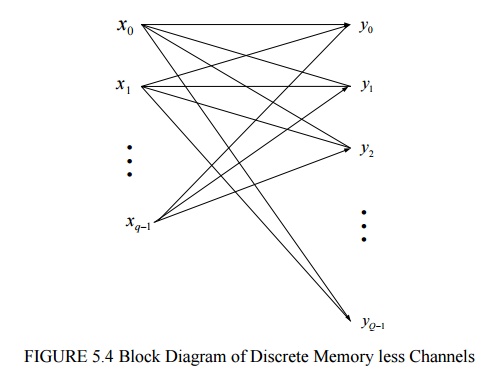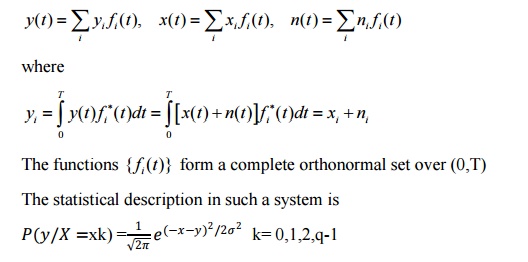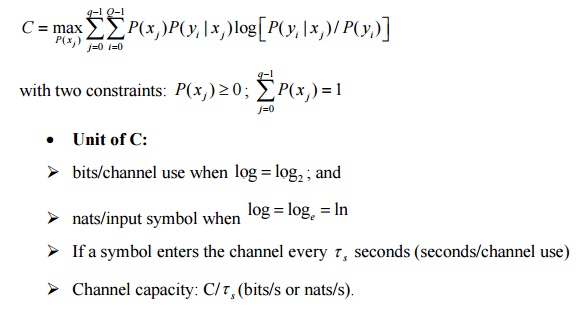Chapter: Communication Theory : Information Theory
Discrete Memory less Channel
DISCRETE MEMORYLESS CHANNEL:
·
Transmission
rate over a noisy channel
Repetition
code
Transmission
rate
·
Capacity
of DMC
Capacity
of a noisy channel
Examples
Ø All these
transition probabilities from xi to yj are gathered in a transition matrix.
Ø The (i ;
j) entry of the matrix is P(Y = yj /jX = xi ), which is called forward
transition probability.
Ø In DMC
the output of the channel depends only on the input of the channel at the same
instant and not on the input before or after.
Ø The input
of a DMC is a RV (random variable) X who selects its value from a discrete
limited set X.
Ø The
cardinality of X is the number of the point in the used constellation.
Ø In an
ideal channel, the output is equal to the input.
Ø In a
non-ideal channel, the output can be different from the input with a given
probability.
·
Transmission
rate:
Ø H(X) is
the amount of information per symbol at the input of the channel.
Ø H(Y ) is
the amount of information per symbol at the output of the channel.
Ø H(XjY )
is the amount of uncertainty remaining on X knowing Y .
Ø The
information transmission is given by:I (X; Y ) = H(X) − H(XjY ) bits/channel use
Ø For an
ideal channel X = Y , there is no uncertainty over X when we observe Y . So all
the information is transmitted for each channel use: I (X;Y ) = H(X)
Ø If the
channel is too noisy, X and Y are independent. So the uncertainty over X
remains the same knowing or not Y , i.e. no information passes through the
channel: I (X; Y ) = 0.
·
Hard and
soft decision:
Ø Normally
the size of constellation at the input and at the output are the same, i.e.,
jXj = jYj
Ø In this
case the receiver employs hard-decision decoding.
Ø It means
that the decoder makes a decision about the transmitted symbol.
Ø It is
possible also that jXj 6= jY j.
Ø In this
case the receiver employs a soft-decision.
ü Channel models and channel capacity:

1. The
encoding process is a process that takes a k information bits at a time and
maps each k-bit sequence into a unique n-bit sequence. Such an n-bit sequence
is called a code word.
2. The code
rate is defined as k/n.
3. If the
transmitted symbols are M-ary (for example, M levels), and at the receiver the
output of the detector, which follows the demodulator, has an estimate of the
transmitted data symbol with
(a). M
levels, the same as that of the transmitted symbols, then we say the detector
has made a hard decision;
(b). Q
levels, Q being greater than M, then we say the detector has made a soft
decision.
ü Channels models:
1. Binary symmetric channel (BSC):
If (a)
the channel is an additive noise channel, and (b) the modulator and
demodulator/detector are included as parts of the channel. Furthermore, if the
modulator employs binary waveforms, and the detector makes hard decision, then
the channel has a discrete-time binary input sequence and a discrete-time
binary output sequence.

Note that
if the channel noise and other interferences cause statistically independent
errors in the transmitted binary sequence with average probability p, the
channel is called a BSC. Besides, since each output bit from the channel
depends only upon the corresponding input bit, the channel is also memoryless.
2. Discrete memoryless channels (DMC):
A channel
is the same as above, but with q-ary symbols at the output of the channel
encoder, and Q-ary symbols at the output of the detector, where Q ³ q . If the channel and the modulator are
memoryless, then it can be described by a set of qQ conditional probabilities
P (Y = y i | X = x j
) º P ( y i | x j ), i = 0,1,...,Q - 1; j = 0,1,..., q -1
Such a
channel is called discrete memory channel (DSC).

If the
input to a DMC is a sequence of n symbols u1
, u2 ,..., un selected from the alphabet
X and the corresponding output is the sequence v1 , v 2
,..., vn of symbols from
the alphabet Y, the joint conditional probability is

the
probability transition matrix for the channel.
3. Discrete-input, continuous-output channels:
Suppose
the output of the channel encoder has q-ary symbols as above, but the output of
the detector is unquantized (Q = ¥) . The conditional probability density functions
p ( y | X = x k ), k = 0,1,
2,..., q -1
AWGN is
the most important channel of this type.
Y = X + G

For any
given sequence X i , i = 1, 2,..., n , the
corresponding output is Yi
, i = 1,
2,..., n
Yi
= X i
+ Gi
, i = 1, 2,..., n
If,
further, the channel is memoryless, then the joint conditional pdf of the
detector‘s output is

4. Waveform channels:

If such a
channel has bandwidth W with ideal frequency response C ( f ) = 1 , and if the bandwidth-limited input signal to the channel is x ( t)
, and the output signal, y ( t) of the channel is corrupted by AWGN,
then
y ( t ) = x ( t )
+ n ( t)
The
channel can be described by a complete set of orthonormal functions:

Since { ni } are uncorrelated and are
Gaussian, therefore, statistically independent. So

ü Channel Capacity:
Channel
model: DMC
Input
alphabet: X = {x0 , x1 , x 2 ,..., xq-1}
Output
alphabet: Y = {y 0 , y1 , y 2 ,..., yq-1}
Suppose x j
is transmitted, yi is received, then
The
mutual information (MI) provided about the event {X = x j } by the
occurrence of the event

Hence,
the average mutual information (AMI) provided by the output Y about the input X
is

To maximize the AMI, we examine the above equation:
(1). P ( y i) represents the jth output of the detector;
(2). P ( y
i | x
j ) represents the channel
characteristic, on which we cannot do anything;
(3). P ( x
j ) represents the
probabilities of the input symbols, and we may do something or control them.
Therefore, the channel capacity is defined by

Related Topics